Solid wood laying technology
A massive board is called a finish floor covering made of a solid solid wood of deciduous or coniferous species, in the sides of which the manufacturer provides grooves and ridges for tight joining with adjacent boards. The floor from the boards of the whole array is distinguished by its presentable appearance, perfectly retains heat, is resistant to stress, durable and environmentally friendly, it is convenient to use and, if necessary, tolerates repeated scrapping, grinding or polishing. If the laying of a massive board is carried out with strict observance of the instructions and the initial quality of the material meets the standards of the technology, then a beautiful and durable floor from it will serve more than one generation.
Content
- Benchmarks and selection criteria
- Types and preparation of laying bases
- Concrete foundation preparation
- The bearing base on the lags
- Base – Existing Wood Floor
Benchmarks and selection criteria
The durability and high performance characteristics of the future natural wood floor equally depend on compliance with the installation instructions and on the original quality of the massive board. In turn, the quality of a solid wood board depends on such factors:
- quality of feedstock;
- equipping the production line of the manufacturing plant;
- modern drying technology.
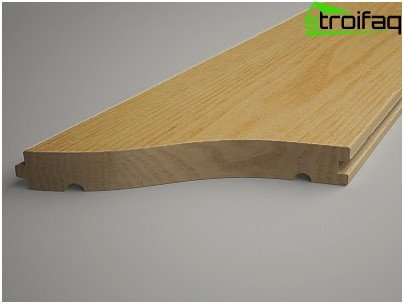
Massive board: grooves and ridges are provided on the sides for tight joining with adjacent boards
Conditioned wood for the manufacture of solid wood floorboards should not contain through holes, knots, mold or rot. The stability of the linear dimensions of the finished product depends on the modern technical equipment of the manufacturer and compliance with the drying technology. In modern woodworking enterprises, the wood is dried under high pressures to a minimum moisture content, impregnated with antiseptics to its full depth, and then the humidity is artificially adjusted to the optimum condition.
In most enterprises, the boards from the massif are ground after drying and applied to the surface with several layers of wear-resistant varnish or coated with oils or wax and the floors from such boards are ready for use right after laying. If the finishing of a natural floorboard from an array in the factory is not completed, then it is produced at the final stage after laying.
A quality solid board should meet the following criteria:
- humidity – 7-10%;
- thickness – 15-30 mm, but can reach 50 mm;
- width – 100-150 mm;
- length – from 50 cm to 3 meters, and occurs up to 6 m;
- permissible deviations of linear dimensions – not more than 0.5 mm.
The strength and basic mechanical characteristics of the future floor depend on the thickness of the massive board. More often than others, boards with a thickness of 20-25 mm are used, but the final choice depends on the type of base for the floor, the type of wood and the purpose of the room.
Types and preparation of laying bases
Solid wood floors can be laid in any room: wooden and stone private houses, as well as in apartments of high-rise brick, panel or concrete concrete houses. The basis for the floor can be:
- reinforced concrete slabs of floors;
- supporting metal or wooden structures – lags;
- supporting pillars of the first floor of a private house;
- old wood floors.
In all these cases, the same technology of laying a massive board is used, but the preparation of each type of base has its own distinctive features.
Concrete foundation preparation
The concrete base, if required, is leveled with a cement-sand screed.
Important: it is recommended that you install hardwood floors on fresh concrete only 2.5-3 months after pouring. The degree of readiness of the base is checked by tightly pressing a small sheet of polyethylene to the surface. If after 48 hours condensation does not settle on the side of the film, the base is suitable for continuing floor work.
A vapor barrier layer of foamed polyethylene or ground mastic is laid on a dry and even base. The polyethylene film can be overlapped or butt, gluing panels with construction tape.
On top of the vapor barrier layer, sheets of moisture-proof plywood are laid, previously sawn along the smaller side into strips of 40-60 cm wide. Fragments of the plywood base are laid diagonally or staggered so that between them there is a gap of 2-3 mm, and between the extreme sheet of plywood and the wall there is a gap of about 10 cm. Having laid the plywood base, it is firmly fixed to concrete using screws with dowels at the rate of 15 attachment points per 1 sq.m. The screw heads are recessed to a depth of 3-4 mm.
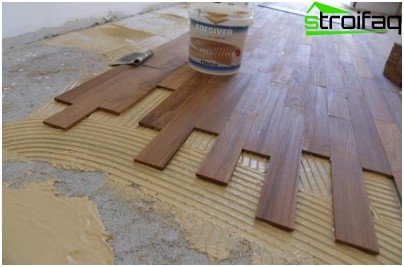
A massive board no thicker than 25 mm can be laid on a concrete base
If soil mastic is used as a vapor barrier, the plywood base can be glued. To do this, the mastic is diluted with a solvent to the optimum consistency, applied to concrete, and prepared plywood sheets are glued to it, applying adhesive compatible with the mastic to them.
Important: on a plywood base laid on concrete, you can lay floors from a massive board, if its thickness does not exceed 25 mm.
The bearing base on the lags
The bearing base on the logs is used when arranging the floor in new houses with a very uneven concrete base, the floors on the supporting poles on the first floors of private houses, as well as in cases when it is planned to use an array of solid wood with a thickness of more than 25 mm as a finishing coating. The arrangement of the bearing base on the logs is very popular, since the design does not require water operations, subsequent drying and is mounted quite quickly.
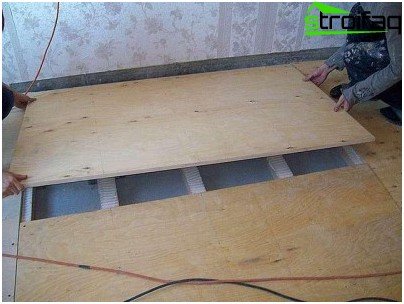
Preparation of the bearing base on the logs: plywood flooring on an already arranged and aligned structure from the logs
Logs are called wooden rectangular bars, usually with a cross section of 50×55 mm and a length of 70-100 cm. They are fixed to a concrete or other base with screws with dowels perpendicular to the direction of the floorboard. The lag step, as a rule, is 25-30 cm, and the distance between adjacent points of attachment to the base is at least 50 cm.
A layer of mineral wool is laid in the space between the lags, which at the same time performs the function of thermal insulation and noise protection, which is especially important for the first floors. On top of the lag, a layer of vapor barrier material is laid and fastened with a construction stapler, and finally a black floor is laid from moisture-proof plywood – the basis for laying the board.
Base – Existing Wood Floor
The existing wooden floor can serve as the basis for laying a massive board, if there is a firm confidence in its strength. Otherwise, it is better to dismantle it and create a new modern foundation. If there is no doubt, the old floor is ground with a grinder, installing a coarse sanding belt, thoroughly cleaned from dust and a waterproofing layer of ordinary or foamed polyethylene is laid.
The massive board in this case is laid in the same direction as the boards of the main floor. If a different direction of the finish coating is expected, a layer of moisture-proof plywood with a thickness of about 12-15 mm is laid on top of the sanded existing floor of the base.
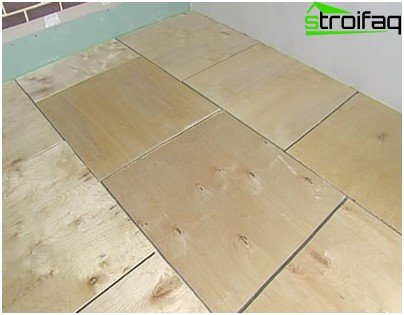
Before laying a massive board, the plywood base is ground and dust removed
Thus, regardless of the design of the base of the floor, its finish is waterproof plywood. Before laying the final flooring from a massive board, the rough plywood floor is sanded with a grinder and dust removed.
Laying methods: glue and glueless
A floorboard made of solid wood is glued or glueless. With the use of glue, a board is made of valuable species of wood, which, as a rule, is thinner than common species, and its length rarely exceeds 2 m – the high price has an effect. The glue method of laying a massive board is also preferable when arranging the floor in rooms of a very large area or complex irregular contour, as well as in very small areas, for example, in the area of door and arched openings.
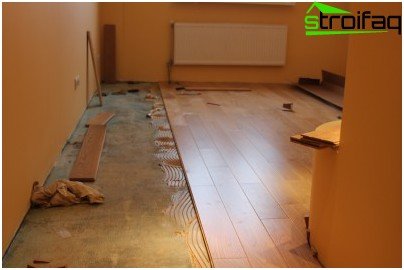
A massive board of valuable wood is laid on the glue, not very thick and not very long
When gluing the floorboards, the massive boards are glued to the base with special glue, tightly joined together in the transverse and longitudinal directions and fixed to the base in the side joints with self-tapping screws at an angle of 45 °, recessing the caps to a depth of 3-5 mm.
The solid wood floor glued to the base is resistant to seasonal deformations, durable, it does not need expansion joints. At the same time, it is very moody when the temperature and humidity indicators are higher than the permissible ones and is not at all suitable as a finishing floor covering in heating systems “warm floor”. Finally, to replace even a small damaged area, you have to completely dismantle the entire adhesive floor.
A more modern glueless way of laying a massive board is simple in execution and is always used when working with products equipped with a tongue-and-groove locking system.
Solid wood laying
On the eve of the start of flooring, a massive board should be brought into the room, removed from the packaging, stacked and left for 3-5 days. This is necessary so that the material accepts the temperature and humidity of the environment and subsequently does not deform during the operation of the floor.
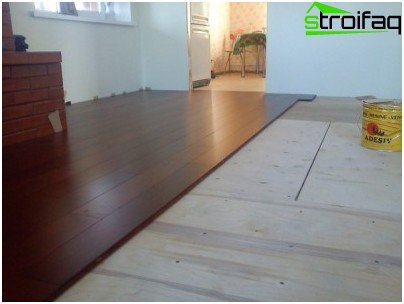
Laying a massive board with your own hands will not create problems even for a layman
If the base for the floor is properly prepared and high-quality material is selected, laying a massive board with your own hands will not create problems even for lay people. Manufacturers recommend laying a board from an array at a relative humidity of not higher than 60% and an air temperature of 10-30 ° C. Most often, a massive board is laid parallel to the direction of light from the illuminated window itself, but any other solutions are possible, for example, diagonally.
Laying the first row of floorboards begins along the longest wall, parallel to the axis of the floor, spike to the wall, align and fix with screws so that they can be covered with a skirting board. The side of the board opposite the wall is fixed to the base or lags, screwing the self-tapping screw into the groove at an angle of 45 °. Fixation to the base is performed with wood screws, the length of which should be 2-2.5 times the thickness of the board.
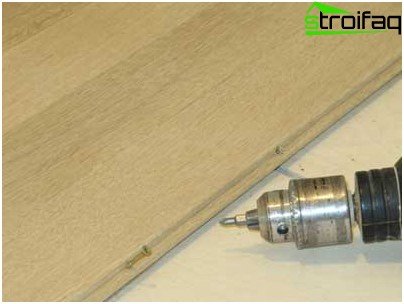
Each floorboard must be fixed on all adjoining lags
Important: Each floorboard must be fixed on all lags with which it is in contact..
Each next row of boards is laid with a spike in the groove of the boards of the previous row, not forgetting to fasten to the base with screws. For the most tight fit of the floorboards to each other, they are customized with the help of pads. The last row of boards, like the first, is fixed to the base with self-tapping screws so that they can be hidden under the baseboard. Between the extreme rows of floorboards and the walls leave a temperature gap of 8-10 mm.
Solid wood finish
If a massive board with a factory-applied finish was used for the floor, the floor can be operated immediately after installation. In the case of using an untreated solid wood board, the newly laid floor should “settle” for about a week, then it is sanded and coated with two layers of varnish to prevent drying out or waterlogging.
A natural wood floor is also subject to mandatory grinding if the difference in thickness of two adjacent boards exceeds the permissible 0.5 mm and is noticeable. The massive board is ground along the fibers using an abrasive belt with a grain of 0.15 mm. If defects, dents, burrs appear on the surface of the floorboards during installation, they should be puttied, sanded and only then varnished.
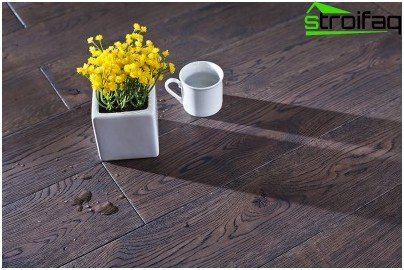
After laying, the floor from the massive board is varnished or impregnated with oils and wax formulations
Fans of a natural wooden floor can use special oil-wax compounds for coating wood instead of varnish. Means based on natural oils and wax, unlike varnishes, impregnate the solid wood board throughout its thickness, creating the thinnest protective film on the surface. Such a coating effectively accentuates the natural texture of wood, protecting it at the same time from damage by insects, mold or fungi.
The practicality of a massive board as a floor covering has been proven over centuries of trouble-free service, it is beautiful, spectacular, respectable. Despite the venerable age of use, a solid wood board never goes out of fashion, lends itself to all types of processing, up to artificial aging, so popular among designers when creating interiors in the “vintage” style.






